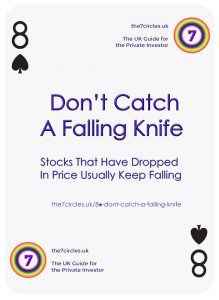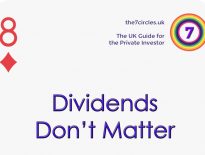8♠ – Don’t catch a falling knife
Don't catch a falling knife - stocks that have dropped in price usually keep falling

This post is part of the MoneyDeck series, a pack of 52 playing cards that describe 52 “golden rules” for Private Investors in the UK.
Don’t catch a falling knife – stocks that have dropped in price usually keep falling
Today I’m going to try to persuade you not to catch a falling knife.
A falling knife is a stock whose price is going down.
- Inexperienced investors often think that the fall in price means that they are getting a bargain, and that the stock will soon recover to its former price.
- But it won’t.
Stocks fall for a reason, and whatever the reason is, the stock is no longer worth what it once was.
- People who catch a falling knife usually end up getting cut.
It’s much better to wait for an asset to stop falling and start to recover, than to try to predict what the bottom will be.
Daniel Kahneman looked at why people think that they can predict the market’s turning points in his book Thinking, Fast and Slow.
He came up with three reasons behind it:
- we all believe that we have special insights that give us an advantage over other people (in the same way that we all think that we are good drivers)
- when things change quickly (such as a rapid drop in the price of a share or a market), we use our “fast” thinking system – our intuitions, the fight or flight response
- we’d be better off slowing down and analyzing why the price is falling
- despite plenty of evidence that the market is unpredictable, the entire finance industry attempts to persuade us that we can outperform by buying an active fund
- the massive marketing budgets of the asset managers confuse us
We ought to make a distinction at this point between catching a falling knife and the process of value investing.
Value investors had a clear idea of what a stock should be worth – it’s “intrinsic value”.
- They’ve already done their homework.
When the price of a stock falls, it can mean that the difference between the stock price and the intrinsic value now exceeds what value investors call “the margin of safety”.
- So a value investor would be confident that they were buying a bargain.
This is different from the investor who tries to catch a falling knife.
- They don’t know what the intrinsic value of a stock is.
- They just know that it’s a lot cheaper than it was yesterday (or last week, or last month etc).
But even value investors would be well-advised to determine the reasons behind the recent price fall, and to evaluate whether these reasons are likely to continue.
- There may be better bargains around, or at least bargains that are likely to rise in price sooner.
Stockopedia recently did a study on profit warnings, which we covered here.
- A profit warning is basically an announcement from a company that their next set of results won’t be as favourable as the analysts are predicting.
- Their profits will be below the consensus estimate or “market expectations”.
Naturally, the stock price is likely to fall on this news.
- What Stockopedia looked at was whether it’s worth holding or even buying the stock after that fall in price.
- Or to put it another way: should you catch a falling knife?
Lots of people think that it’s generally a good time to buy after a profit warning.
Stockopedia explained this in terms of psychological (cognitive) biases:
- we are all averse to taking a loss (loss aversion)
- we like to believe stories rather than facts (narrative fallacy)
- we are anchored on the stock’s price before the PW (anchoring)
Stockopedia looked at 245 profit warnings between January 2013 and August 2106.
- Most of the companies were UK small caps.
They found that it was not a good idea to buy a stock after a profit warning.
- These stocks continued to fall, under-performing a gently rising market for the next 350 trading days (almost 18 months).
- There was on average no “bounce” or recovery.
(( Interestingly, they also underperformed the market during the 100+ days (around six months) before the PW – this implies insider trading or leaking of information, or possibly sector pressures reflected in warnings from other firms ))
Stockopedia sell data on stocks, based around the concept of Stock Ranks for Quality, Value and Momentum.
- They found that stocks with high Quality and / or Value scores were more likely to announce PWs.
- But high Quality stocks were more likely to recover after a profit warning.
Those with good Momentum scores (whose share prices have been rising) were less likely to have a profit warning.
(( This is to be expected since Stockopedia found that stocks with profit warnings had been underperforming the market in the previous six months. Defensive stocks are also less likely to issue a profit warning when compared to cyclicals ))
Another recent study was by Andrew Lapthorne of Soc Gen.
- He looked at portfolios of companies that had fallen by 20%, 30%, 40% and 50% from their 12-month peak.
- He used stocks from the FTSE-World index between 1990 and 2015.
And he only constructed portfolios from periods where there were at least 20 companies that met the various criteria.
- When there were fewer than 20 stocks for a portfolio, the performance was taken as zero.
Although there were some periods of outperformance (what Lapthorne called the “dash to trash”), all of the portfolios eventually underperformed the market.
- Stocks that had fallen the most generally underperformed the most.
Performance declined from one month through to nine-month holding periods, improving slightly (though remaining negative) for a 1 year holding period.
- Lapthorne said that even longer periods showed a similar pattern.
To test whether the underperformance resulted from concentration in particular countries or sectors that were doing badly, Lapthorne also looked at performance relative to these countries or sectors.
- Although underperformance was lower (for example, -5% over nine months, rather than -7%), it was still present.
- And the pattern of deteriorating performance from a one month to a nine-month holding period, followed by a slight improvement to twelve months was also repeated.
Lapthorne did find one exception to the rule.
- When the whole market is cheap (as measured by the percentage of “beaten-down” stocks within the market), then buying the falling knives does work.
But the same result was found if valuation measures such as PE was used instead of the fall in share price.
- So it seems than in a cheap market, buying falling knives correlates closely with buying value stocks.
So remember, unless the whole market is cheap: (( And it isn’t at the moment )) Don’t catch a falling knife – stocks that have dropped in price usually keep falling.
Until next time.

















